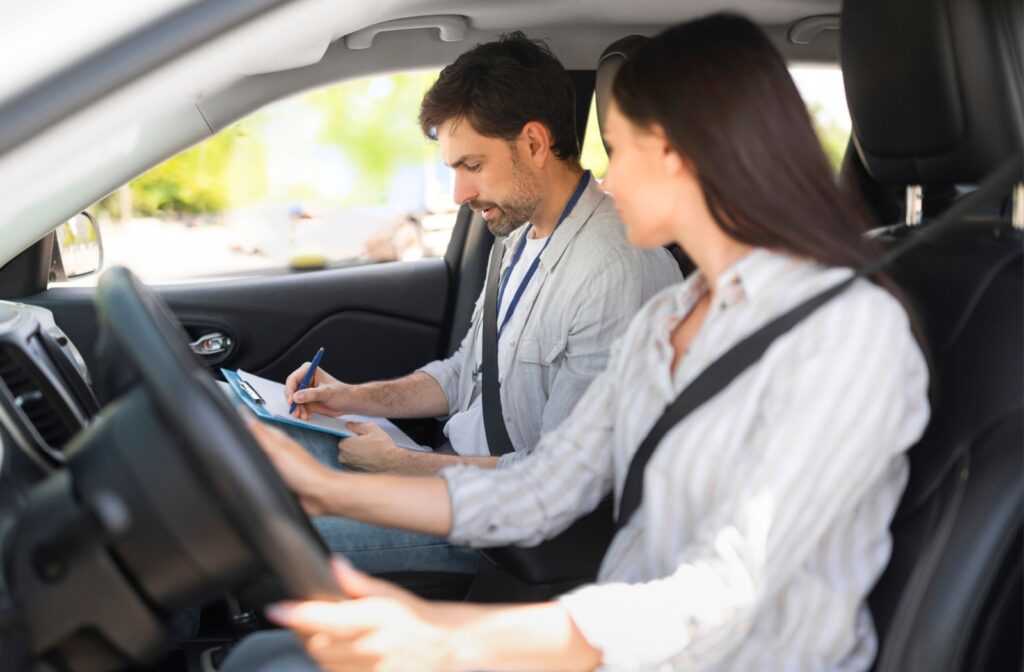Contrary to common belief, being legally blind doesn’t automatically bar someone from driving. In California, legal blindness is defined by a visual acuity of 20/200 or worse in the better eye, or a very restricted visual field. However, whether someone with this classification can legally drive depends entirely on whether they meet the state’s vision standards and can demonstrate safe driving abilities.
Yes, legally blind people can drive in California if their corrected vision meets the state’s minimum standards and they pass any required evaluations. According to the California DMV, to qualify for a standard driver’s license you must have at least 20/40 vision when both eyes are used together, or 20/40 in one eye and at least 20/70 in the other, with or without corrective lenses.
If your vision falls below these thresholds, yet remains better than 20/200 in one eye, you’ll be referred to a vision specialist who will complete a Report of Vision Examination (Form DL 62).
Understanding the Term “Legally Blind” in California
“Legal blindness” in a medical context means having best-corrected vision of 20/200 or worse in the better-seeing eye, or a visual field spanning 20 degrees or less. However, California’s DMV focuses on whether corrected vision meets its licensing thresholds, not on the blindness label alone.
Many people who are classified as legally blind still retain central vision sharpness, peripheral awareness, or light perception. For instance, someone with a peripheral field under 20 degrees yet good central acuity might still qualify, if their corrected vision reaches at least 20/40 in one eye (and 20/70 in the other).
Vision Standards for Driver’s License in California
California DMV requires all applicants (new or renewal) to pass visual screening: 20/40 vision together, or 20/40 in one eye and at least 20/70 in the other, with or without corrective lenses. Failing this triggers a referral for a Vision Specialist Evaluation (Form DL‑62). Applicants must also demonstrate at least 20/200 visual acuity in one eye, corrected, but are disallowed from using bioptic telescopic lenses to meet this baseline.
If the minimum standards are met via correction, a license may be issued, possibly with restrictions like corrective lenses or daylight-only driving, or after further testing via a Supplemental Driving Performance Evaluation.
Vision Loss Alone Isn’t Enough to Prohibit Driving
Legally blind status doesn’t categorically disqualify someone from driving. What matters is whether corrected vision meets or exceeds California’s standards, and whether the person can pass a road test demonstrating safe driving. Those achieving corrected acuity standards, like 20/40 and 20/70 in the weaker eye, may qualify, despite low vision classification. Those who don’t meet the vision screening may be permitted to drive only after submitting a DL‑62 form and passing a behind-the-wheel test showing they can compensate safely.
Road Testing & Adaptive Techniques in California
California’s DMV vision screening is not just about medical thresholds; it’s a gateway to determining driving competence. If initial screening fails, a vision specialist’s evaluation and possibly a Supplemental Driving Performance Evaluation will assess whether someone can compensate for their impairment through structured adaptive techniques, such as scanning routines or mirror use, and with the use of corrective lenses or daytime driving only restrictions.
Successful demonstration of safe driving may result in a restricted license, but unsafe performance can lead to suspension or revocation.

The Role of Vision Care Professionals
Eye care providers are integral to evaluating whether a person is eligible to drive. Through comprehensive exams, they measure visual acuity, peripheral field, contrast sensitivity, and depth perception. They guide patients through understanding licensing thresholds and exploring corrective interventions; whether glasses, contact lenses, or low-vision aids.
They also help people interpret what their vision limitations mean in practical terms. For people who may not meet standards, optometrists can refer them for mobility training, discuss alternate transportation options, or assist in appeals for adaptive licensing.
When Driving Isn’t an Option
If someone does not meet the vision standards, driving isn’t necessarily off the map forever. Vision loss may be temporary or progressive, and reassessments are possible. Many regions permit appeals or conditional licenses after rehabilitation or treatment. Ongoing vision rehabilitation services help people develop compensatory skills, and on-road testing may be offered after training.
Some drivers participate in specialized programs where they learn to drive with additional assessments, perhaps focusing on safe daytime driving or routes that avoid complex highway entry points.
Living With Restricted Vision
When licenses are restricted or revoked, lifestyle adjustments may follow. For instance, public transit, ride shares, slowing schedules, and support networks are all possible alternatives. Many people also explore occupational therapy, mobility training, and technology such as high-contrast signage and handheld magnifiers to support independence in other areas of life.
A Personalized Path to Mobility
Whether someone who is legally blind can drive does not yield a simple yes or no. It depends on whether corrected vision meets licensing requirements, whether the person can demonstrate safety behind the wheel, and whether adaptations have been successfully integrated. Many legally blind people can meet these requisites with the right tools, training, and support.
So while legal blindness often signals a limit, it isn’t always a full stop. With thorough assessment, corrective methods, and training, some people classified as legally blind may still be able to drive within a regulated framework.
When that doesn’t apply, Dr. Goldstone Optometry helps guide a safe transition to alternative transportation, preserving quality of life and independence in other meaningful ways.



